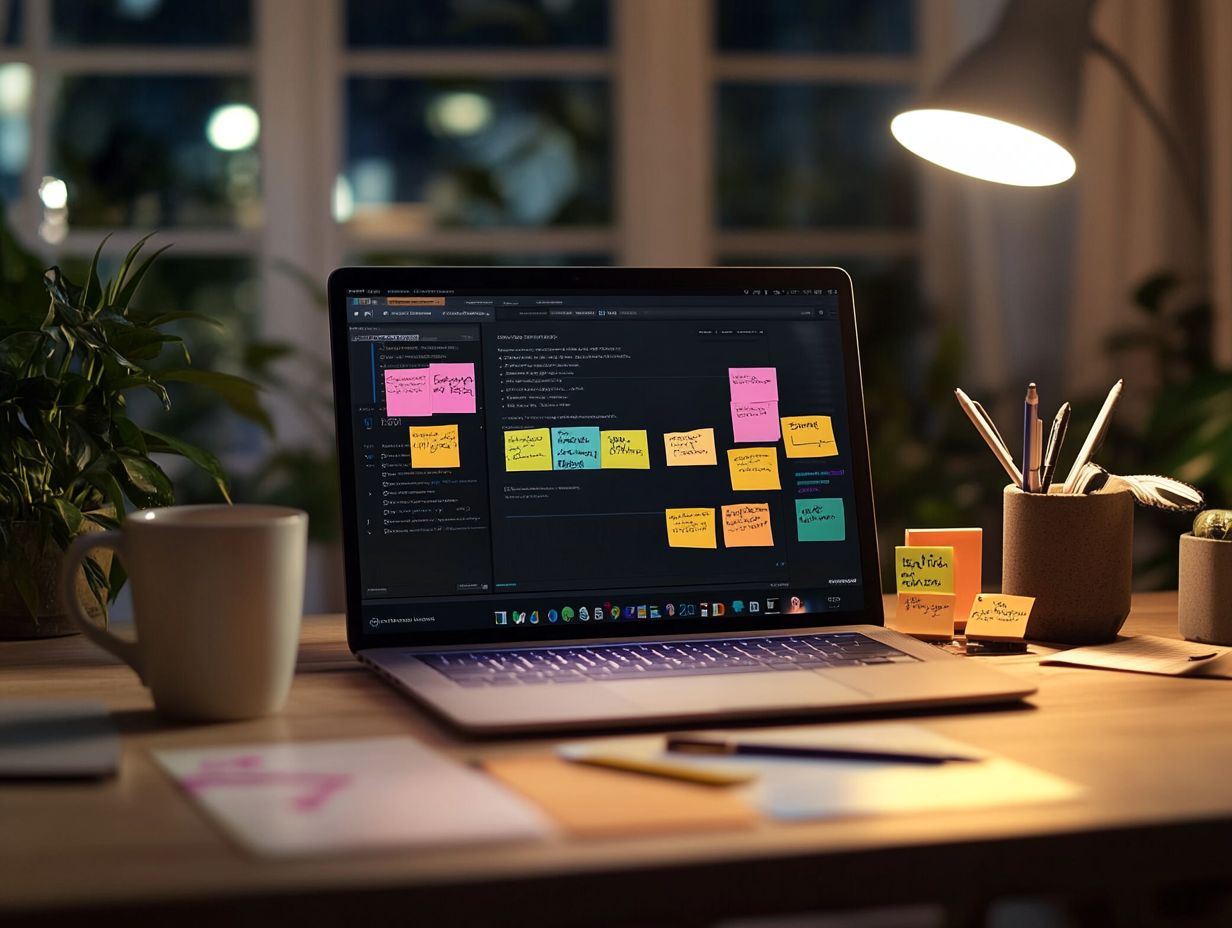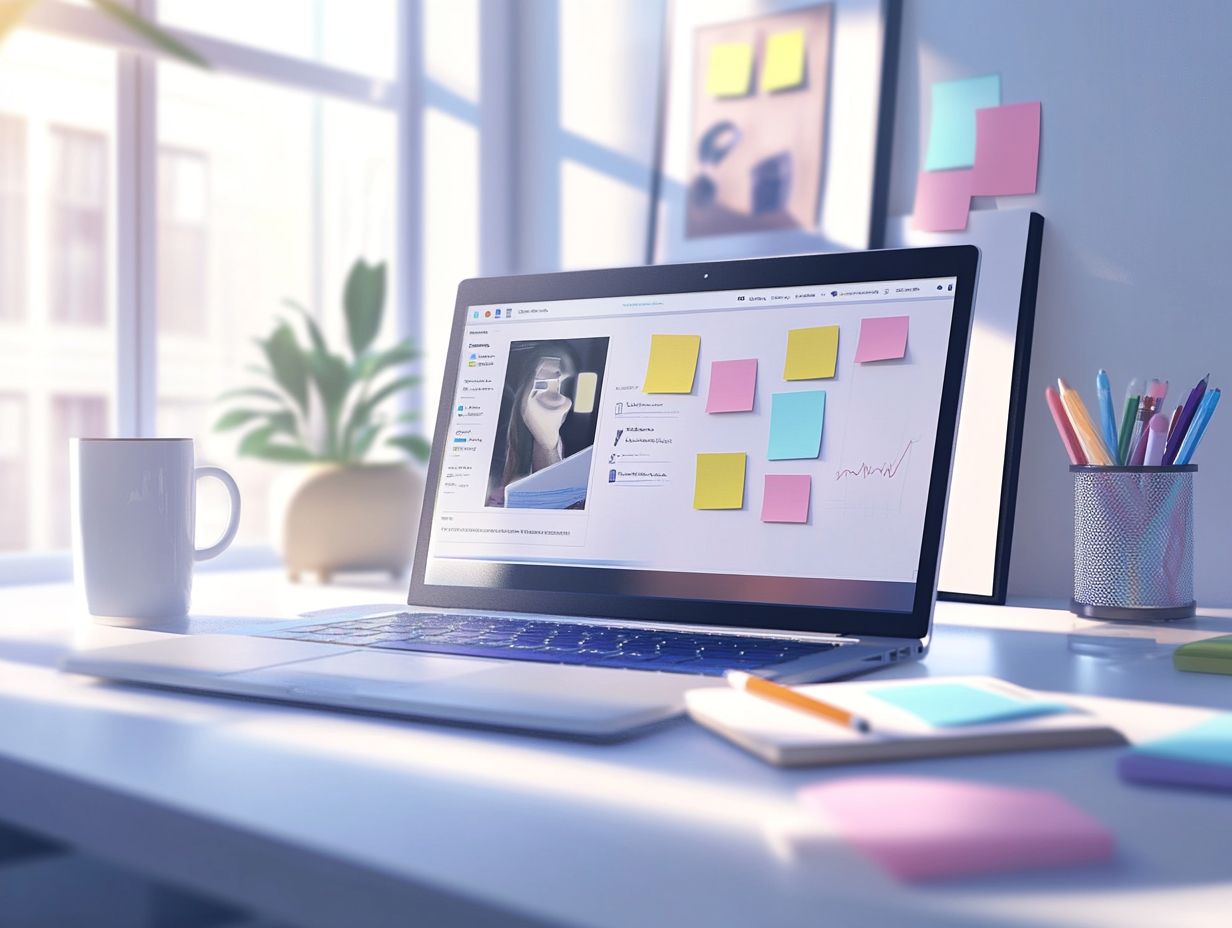5 Tips for Creating Engaging E-Learning Videos
Creating engaging eLearning videos is crucial in today s digital learning environment. With attention spans dwindling, capturing your audience s interest while delivering valuable content is a challenge.
This article presents five practical tips to enhance your eLearning videos, ensuring they are informative and captivating. From establishing clear objectives to incorporating interactivity and maintaining professional production quality, you ll discover tools and techniques to elevate your video content.
Get ready to revolutionize your e-learning approach today!
Contents
- Key Takeaways:
- 1. Start with a Clear Objective
- 2. Keep It Short and Concise
- 3. Use Visual Aids and Graphics
- 4. Incorporate Interactivity and Quizzes
- 5. Use Professional Audio and Video Equipment
- What Are the Benefits of Using Videos in E-Learning?
- Frequently Asked Questions
- Ready to Create Engaging E-Learning Videos? Here Are 5 Tips!
- How Can a Clear and Concise Script Boost Your E-Learning Video?
- Why Are Visual Aids and Graphics Game-Changers?
- What Role Do Interactive Features Play in Engaging E-Learning Videos?
- How Does Varying Pace and Tone Impact Engagement?
- Why is High-Quality Production Essential?
Key Takeaways:

- Clearly define objectives to guide video creation.
- Keep videos concise for better retention.
- Use visuals and interactivity to keep learners engaged.
1. Start with a Clear Objective
Establishing a clear objective is fundamental in eLearning. It lays the groundwork for your content development and guides your video production, enhancing the learning experience for users engaging with online courses or training videos.
A well-defined goal ensures that you and your learners understand the desired outcomes. This allows for effective use of educational tools and training programs, maximizing the value of video content through structured learning strategies.
When you utilize specific objectives in your eLearning initiatives, you can harness advanced tools that help manage online learning and analytics software to track progress and assess learner outcomes. Platforms like Moodle or Blackboard enable you to create modules that directly correspond with set goals, ensuring seamless alignment between content and assessment methods.
Picture creating a video series that intricately dissects complex concepts, integrating quizzes and gamified elements to measure understanding and engagement. This meticulous alignment enriches the educational process, fostering a more impactful and interactive learning journey for you and your audience.
2. Keep It Short and Concise
In the fast-paced realm of online education, keeping your videos short and concise is essential for maintaining student engagement and enhancing learning retention, especially given the limited attention spans of viewers.
Research indicates that the ideal length for educational videos typically falls between six and eight minutes. This strikes a perfect balance between delivering necessary information and allowing for audience interaction. A study from MIT reveals that videos exceeding ten minutes often experience a notable decline in viewer retention rates.
To create impactful video tutorials, break down complex topics into digestible segments. Use clear visuals and bullet points to reinforce key ideas, ensuring your audience can easily grasp the content. Additionally, consider 5 ways to enhance accessibility in e-learning by incorporating engaging questions or prompts to stimulate interactivity, encouraging viewers to think critically about the material you present.
3. Use Visual Aids and Graphics
Incorporating visual aids and graphics in your eLearning videos can significantly elevate comprehension and retention. Visual storytelling captures your audience’s attention and clarifies complex concepts through engaging multimedia elements.
Use infographics to clarify data and present information succinctly. Animation techniques can also help illustrate processes that might be challenging to convey with words alone. Actual video demonstrations allow you to showcase real-life applications of theories in action, deepening understanding.
Many educational platforms leverage animated explainer videos to break down intricate ideas, such as the laws of physics, into easily digestible segments. Similarly, compelling infographics in business courses can effectively showcase market trends, creating a learning experience that is both interactive and enjoyable.
4. Incorporate Interactivity and Quizzes

Integrating interactivity and quizzes into your eLearning videos can truly elevate the experience, fostering active participation and enhancing student engagement. This transforms the viewing process into an interactive journey that reinforces learning strategies and promotes better retention.
This dynamic approach grabs attention and compels you to reflect on the material, enriching your overall educational experience. Platforms like Kahoot and Edpuzzle perfectly demonstrate how quizzes can be seamlessly woven into video content, enabling you to assess comprehension in real-time.
To maximize the effectiveness of these tools, consider these best practices:
- Place quizzes at strategic points throughout the video.
- Utilize diverse question formats.
- Provide timely feedback to clarify any misunderstandings.
By implementing these strategies, you ll keep learners engaged and motivated while effectively reinforcing their knowledge.
5. Use Professional Audio and Video Equipment
Using professional audio and video equipment is essential to create high-quality videos that capture your viewer’s attention and enhance the overall learning experience, especially for training videos and educational content.
To achieve this, investing in top-notch cameras that shoot in high-definition is a must for delivering clear and vibrant visuals. Professional microphones greatly improve audio clarity, ensuring that every word resonates crisply and is easy to understand. By using reliable editing software, you can stitch together footage, insert graphics, and refine sound to maintain a polished appearance.
In educational settings, a well-crafted voiceover adds professionalism and engagement, guiding your viewers through the material and making complex topics more approachable. Prioritizing high-quality visuals and sound not only draws in your audience but also cultivates a more effective learning environment.
What Are the Benefits of Using Videos in E-Learning?
The integration of video into eLearning revolutionizes the educational landscape, offering you a wealth of benefits such as heightened learner engagement, improved knowledge retention, and efficient delivery of educational content. This makes video a critical tool for both employee training and broader learning goals.
Video captivates your audience and makes complex concepts easier to understand through effective visual demonstration techniques. By blending auditory and visual elements, it caters to various learning styles and reinforces comprehension. Learning analytics reveal that incorporating video can boost retention rates by up to 80%, as highlighted in a study by the University of Massachusetts.
In the realm of video marketing, companies using video content experience revenue growth that s 49% faster, showcasing its power to engage and convert. These statistics emphasize the importance of video as a versatile medium, significantly enhancing both educational and marketing effectiveness.
How Can One Create a Script for an E-Learning Video?
Creating a compelling script for your eLearning video requires meticulous planning and structuring. Ensure it aligns with your learning objectives while effectively engaging your audience through clear communication and educational tools.
Start by understanding your target audience and defining the key messages that will resonate with them. Planning the video scenes is crucial here, as it helps you visually map out the script s flow, organizing your ideas and maintaining a coherent narrative. By incorporating storytelling elements, your eLearning script can forge emotional connections that enhance retention. It s essential to strike the right balance, providing just enough information to inform without overwhelming your learners.
Using concise language and engaging visuals will elevate your content delivery, ultimately crafting an impactful learning experience that leaves a lasting impression. Start using these strategies now to enhance your eLearning experience!
What Are the Different Types of E-Learning Videos?

E-learning embraces a range of video formats, each meticulously crafted to fulfill distinct purposes, such as explainer videos, video tutorials, and interactive videos. These formats are tailored to accommodate various learning preferences and objectives.
They not only grant you flexibility but also significantly boost engagement and retention. For instance, explainer videos excel at breaking down complex concepts with visuals and succinct narratives. This makes them perfect for introductory courses.
Video tutorials provide step-by-step guidance, proving especially beneficial for practical skills like coding or crafting. Then there are interactive videos, which elevate the experience by actively involving you in the learning process. They allow you to make choices that influence the content flow enhancing both understanding and application.
By harnessing these diverse video types, you can cultivate a rich, multifaceted learning environment that addresses a wide array of educational needs.
How Can One Make E-Learning Videos Accessible?
Ensuring that eLearning videos are accessible to all learners is essential. You can achieve this through thoughtful technology integration and the application of inclusive learning strategies.
Implementing features like captions provides clearer comprehension of the material, catering to those with hearing impairments or language barriers. Incorporating audio descriptions enables visually impaired students to engage more fully with the content.
Using different formats like interactive videos or transcripts supports various learning preferences. This commitment to inclusivity enhances the educational experience for students with disabilities and enriches the learning environment for everyone, fostering a collaborative space where all can thrive and contribute.
What Are the Common Mistakes to Avoid When Creating E-Learning Videos?
Creating effective eLearning videos means steering clear of common mistakes that can undermine learning outcomes. For instance, consider creating engaging content for e-learning to avoid issues like poor content delivery, lack of engagement, and subpar video editing.
These pitfalls diminish the overall quality of your material and can lead to frustration and disengagement among learners. To truly enhance the effectiveness of your eLearning videos, focus on delivering content clearly while prioritizing your audience’s needs. Exploring 5 tools for creating interactive e-learning can also help improve engagement and retention.
Crafting concise scripts with relatable examples makes your content shine! Incorporating interactive elements, such as quizzes or discussion prompts, can significantly elevate engagement levels. Proper video editing is crucial; smooth transitions and high audio quality are key to keeping your viewers focused.
Thoughtful planning and execution are essential for crafting compelling content that resonates with your audience, ultimately boosting knowledge retention.
How Can One Measure the Effectiveness of E-Learning Videos?
It s essential to measure how effective your eLearning videos are! You can accomplish this through various methods, including using tools that track how viewers interact with your videos and collecting feedback from your learners.
By utilizing metrics like engagement rates and completion statistics, you can gain valuable insights into how your audience interacts with the content. Tools designed to track these elements enable you to identify sections that may present challenges and illuminate potential gaps in comprehension.
Furthermore, soliciting learner feedback adds a qualitative layer that enriches your numerical data, spotlighting areas for content improvement. Together, these analyses enable you to refine your educational material, ensuring it resonates with your target audience and fosters a more effective learning experience.
Frequently Asked Questions

Ready to Create Engaging E-Learning Videos? Here Are 5 Tips!
The top 5 tips for creating engaging e-learning videos are:
- Have a clear and concise script.
- Use visual aids and graphics.
- Incorporate interactive features, like quizzes and polls.
- Vary the pace and tone of the video.
- Ensure high-quality production.
How Can a Clear and Concise Script Boost Your E-Learning Video?
A clear and concise script grabs the viewer’s attention and makes the information easy to understand.
It helps avoid confusion and rambling, making the video more engaging and effective!
Why Are Visual Aids and Graphics Game-Changers?
Visual aids and graphics are game-changers! They make content visually stunning and keep viewers on the edge of their seats.
These elements break up the content and help explain complex concepts, making information a breeze to grasp.
What Role Do Interactive Features Play in Engaging E-Learning Videos?
Features that let viewers participate, like quizzes and polls, are vital! They encourage active participation and make the learning experience memorable.
They also offer immediate feedback and reinforce key concepts, keeping learners engaged!
How Does Varying Pace and Tone Impact Engagement?
Varying the pace and tone keeps viewers interested and prevents boredom.
This approach adds excitement and emotion, making the learning experience truly enjoyable!
Why is High-Quality Production Essential?
High-quality production with great lighting and sound is essential! It boosts professionalism and keeps viewers hooked.
This creates a better learning experience and maintains engagement throughout the video.






